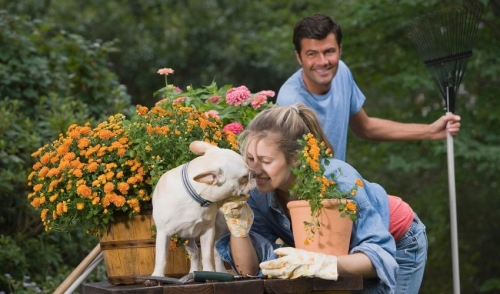
Tips for Gardening With Pets
Gardening can be a productive and enjoyable hobby, and it can be even more fun when you involve your pets. Different gardening tasks, plants, and equipment aren’t always suitable for pets, however, so it is important to take proper steps to keep your pets safe while you garden together.
How Gardening Helps Pets and Pet Owners
Shared activities strengthen the bond between a pet and their person, deepening the relationship they share, and gardening can benefit both pets and pet owners. Your pets will enjoy the time outside and the mental stimulation provided by different sights, smells, and textures in the garden. They will stay healthier with the exercise of gardening time, and the fresh air and freedom of time in nature can help calm your pet’s anxiety and improve their well-being.
Sharing the garden with your pet can also bring you added benefits. Some pets can be trained for simple fetch-and-carry tasks, such as bringing garden tools to you. Pets might even be trained to dig in an indicated spot, helping out with laborious garden tasks. A patrolling pet will help keep unwanted visitors such as squirrels, chipmunks, and rabbits out of the garden, and you will simply enjoy the companionship of your pet whenever you’re working on gardening tasks.
Tips for a Pet-Friendly Garden
Unfortunately, pets can be a problem in the garden if they aren’t well trained or supervised. A pet might crush, trample, dig up, or chew on plants, urinate or defecate in inappropriate spaces, or chew on tools. Sharp tools can toxic plants can even be dangerous for your pet. There are ways you can discourage these unwanted behaviors and hazards, however, and still enjoy gardening time with your pet.- Plant a pet plot with healthy plants your pet will enjoy. This might include wheatgrass or oat grass for the pet to nibble or lay on, or catnip for your feline friends to use. You can easily train your pet that the pet plot is where they are welcome and accepted in the garden.
- Provide a marking post for your pet where it can safely mark its territory. Your pet will naturally want to define its space, and providing a spot for it to do so will prevent unwanted markings on delicate plants, posts, and other tools.
- Review lists of toxic and non-toxic plants in your area, and be sure you can identify each plant in your garden or landscaping to be sure it is safe for your pet. Remove and replace dangerous plants as needed to make your garden pet-friendly.
- Minimize chemical use in the garden as much as possible so your pet is not exposed to potential toxins in fertilizers, pesticides, or herbicides. Even organic options may not be safe around pets, and you should keep your pet safely out of the garden when chemicals are freshly applied.
- Use firm pet repellants in garden areas where your pet should not be. This could mean sturdy fences around new plantings, or thorny plants as a natural border to keep pets out of certain areas, including a compost pile or around toxic plants.
- Consider creating a garden with raised beds or gardening in containers that will be easier to keep safe from a pet’s unwanted digging or other attention. This will better define your garden area and you can train your pet about which spaces are safe and which are not.
- Create wider pathways in your garden so your pet has a defined pathway to explore and patrol. This will help the animal develop a sense of ownership of the garden, and will encourage them to stay off delicate plants and out of cultivated beds.
- Add games to your pet gardening time, such as throwing a tennis ball for a lengthy game of fetch while you’re working in your garden. Your pet will love the extended exercise and attention even while you complete your garden chores.
- Always provide water and shade for your pet when you are working outdoors, especially during hot summer days. Stay alert for any signs of heatstroke or other discomfort in your pet and take steps to seek emergency care if necessary.
